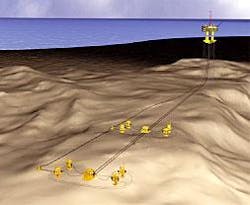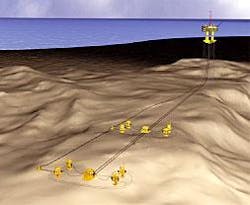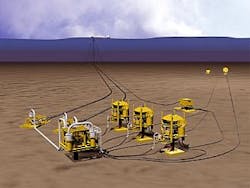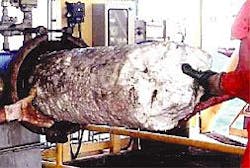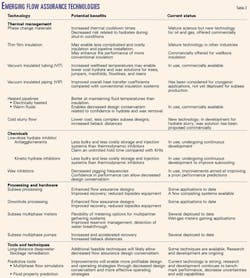Special Report: Ultradeepwater will require less conservative flow assurance approaches
To improve the economics for developing deep and ultradeepwater projects, the oil and gas industry must develop less conservative flow assurance strategies and procedures.
null
Flow assurance is a critical, often defining, aspect of deepwater oil and gas production that affects a production system's concept selection, design, and operating strategy.
Industry is increasing its awareness of the complexity of this effect and, over the last decade, has become better equipped with an extensive tool kit and a myriad of innovative technologies to tackle the difficulties of deepwater flow assurance.
But as the stakes get higher and the risks greater, is industry appropriately ready for the challenges of continued deepwater and ultradeepwater development?
Certainly, industry operates successfully in water depths up to 7,200 ft and implements tiebacks at distances up to 70 miles with proven flow assurance tools and strategies to ensure production and mitigate risks. The extreme nature of deep and ultradeepwater environments, however, presents challenges for viable flow assurance designs.
As a result, current flow assurance solutions, which successfully address these deepwater challenges, typically are conservative because of a multitude of uncertainties and associated risks. These concerns include:
- Uncertainties associated with current flow assurance design tools.
- Incomplete or nonexistent fluid samples and reservoir data.
- Mitigation of risk to health, safety, and environment.
- Mitigation of risk associated with maintaining large revenue streams through capital-intensive facilities.
- High intervention and remediation costs.
These concerns will become more taxing as the industry continues to extend water depths and tieback distances (Figs. 1 and 2).
The capital costs (capex) of these projects will demand less conservative solutions to justify their economics.
To increase the chances of success for these projects, the oil and gas industry must develop flow assurance strategies and procedures that decrease conservatism in deepwater flow assurance designs.
Components of this success include:
- Development of promising tools and technologies.
- Timely qualification of technologies for deployment in new deepwater and ultradeepwater projects.
- Implementation of quality fluid sampling programs.
- Early and active involvement of flow assurance engineers in all phases of project execution
Robust systems
At the highest level, flow assurance consists of designing systems that enable and maintain the flow of production fluids and therefore the revenue stream required to support the economics that are the basis for the development. Specific responsibilities of a flow assurance engineer include evaluating:
- Multiphase thermal-hydraulics to determine line sizes, flow-rate capacities and system deliverability, thermal insulation requirements, and slugging potential.
- Potential hydrate formation and options for preventing hydrate blockages (Fig. 3).
- Wax deposition within a pipeline system and subsequent strategies to manage or remove it (Fig. 4).
- Impact of other undesirable solids, such as asphaltenes, scale, and sand.
- Internal corrosion.
- Operability and operating envelopes of the system.
Flow assurance engineers must design the system and its operations to ensure a problem-free environment while also considering options to remediate blockages if they occur. While blockages are not inevitable, they are a potential reality with significant consequences.
Flow assurance encompasses the flow path from the reservoir through the production facilities to the export system. Engineers must design flow assurance strategies that avoid problems during start-up, steady-state operations, planned and unplanned shutdowns, flow-rate changes, pigging operations, cooldown, and system blowdown.
Each of these operations confronts flow assurance designers. Additionally, engineers must develop robust flow assurance designs and strategies so that systems can adapt to changes in pressures, temperatures, flow rates, water cuts, and reservoir compositions over the life of a field.
Flow assurance designs must result in a single system with flexibility to address these varying concerns. Most importantly, the system must be reliable and safe and must operate in an environmentally responsible manner.
Deepwater flow assurance is a broad discipline that is scientifically and technically complex, requiring technology and expertise in multiphase thermal-hydraulic fluid mechanics, produced fluid chemistry, reservoir behavior and fluid properties, full-field operations, and system operability. The discipline involves complex interfaces with pipeline, subsea equipment and controls, reservoir, topsides processing, and operations teams.
null
Because of this broad scope, flow assurance is best approached from a systems perspective. Ideally, flow assurance involvement with a project begins with a strong fluid-sampling program during the discovery or appraisal stages and continues through concept selection, design, start-up, operations, and surveillance.
Economics, risks
Designers typically make flow assurance decisions by balancing trade-offs between low capex, higher risk solutions and higher capex, more conservative solutions. Higher risk solutions usually have an increased potential for production downtime and high operating costs (opex) in the form of costly and time-intensive intervention and remediation.
null
For instance, a hydrate blockage may take weeks to remediate, impacting the revenue stream, adding operational expenses associated with remediating the blockage, and idling all or parts of a major capital investment. At $25/boe, lost or deferred revenue from a large deepwater production facility could easily exceed $3 million/day.
Because of the large capex involved, $1 billion or more for a large deepwater development, operators understandably pursue conservative designs. Importantly, this conservatism is not a result of ineffective flow assurance practices but rather a reasonable outcome of a design process that must mitigate large risks using design tools that have reasonable limitations associated with current stages of development and experience.
The industry has advanced state-of-the-art flow assurance design tools, but as with any complex science, most solutions rely on assumptions and approximations of science that, as yet, are incompletely understood.
Often, fluid samples are too few and too poor to provide well-defined fluid properties for a good design basis. Other uncertainties include the drive mechanism, expected production profiles, water cut, and well productivity.
Many in the industry feel that risk management, coupled with these uncertainties in flow assurance and reservoir data and design tools, leads to overly conservative designs.
Click here to view the Flow Assurance Design, Operating Strategies table.
Current practices
- Dual flowlines to enable roundtrip pigging for wax management, fluid circulation, and the flexibility to operate over a wide range of flow rates.
- Insulation to keep fluids out of the hydrate formation region and above the wax appearance temperature during normal operations and to provide sufficient cooldown time after an unplanned shutdown.
- Artificial lift used at the wells or near the riser base to help overcome the large hydrostatic head in a deepwater riser.
- Injection of a hydrate inhibitor prior to a planned shutdown and also during restart operations.
- Displacement of the flowline with non-hydrating fluids after an unplanned shutdown.
- Circulation of hot fluids to warm the system prior to production start-up.
- Depressurization or blowdown of the system after an unplanned shutdown to lower system pressure below the hydrate formation envelope.
Deepwater gas and gas condensate systems often rely on:
- A single flowline to tie production back to the host. Dual lines may be used if pigging is required to manage wax or liquid content in the lines.
- Continuous injection of hydrate inhibitor to protect fluids during normal operations and against worst-case conditions expected during shut-in and restart.
- Uninsulated flowlines because insulation offers little benefit for cooldown time and maintenance of fluid temperatures. This condition is a result of the low heat capacity of gas and the potential that Joule-Thomson cooling will depress flowing temperatures below seawater temperature.
- Depressurization or blowdown of the system soon after any interruption in hydrate injection to lower the system pressure below the hydrate formation envelope.
Table 1 lists flow assurance strategies of four recent deepwater developments.
- Improving techniques for locating blockages.
- Enhancing mechanical methods such as using coiled tubing to drill or jet out blockages and deliver thermodynamic hydrate inhibitor.
- Extending coiled tubing reach with flowline tractors, for example.
- Determining other ways to deliver chemicals wherever and whenever they are needed in the flow path.
- Delivering controlled exothermic chemical reactions to melt wax constrictions in the flow path.
